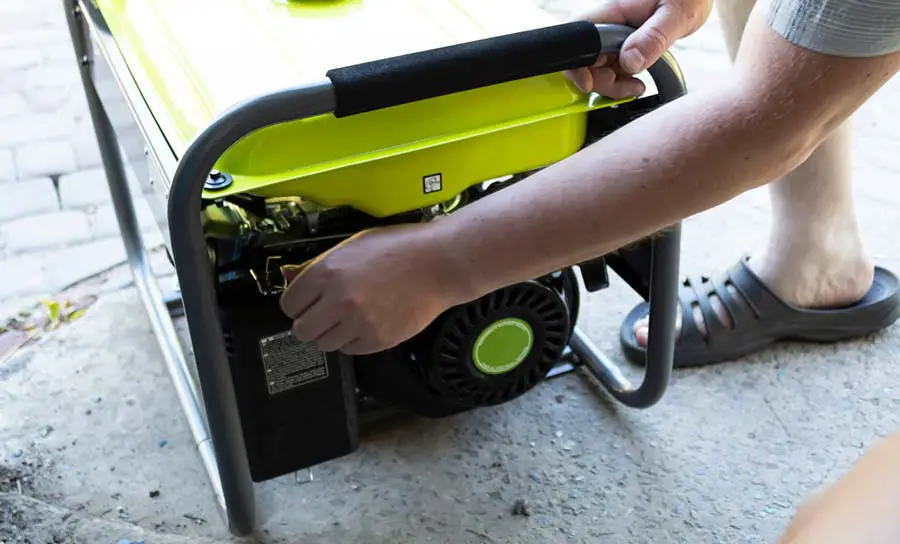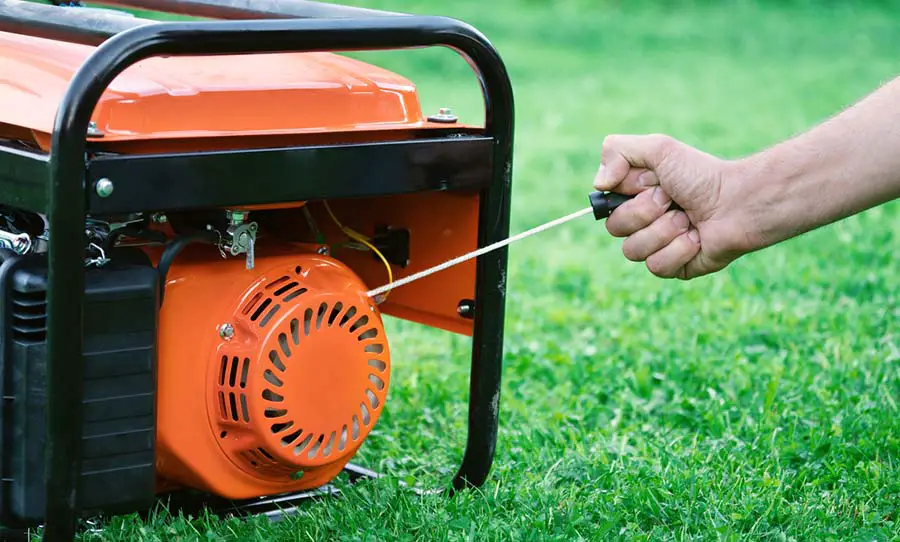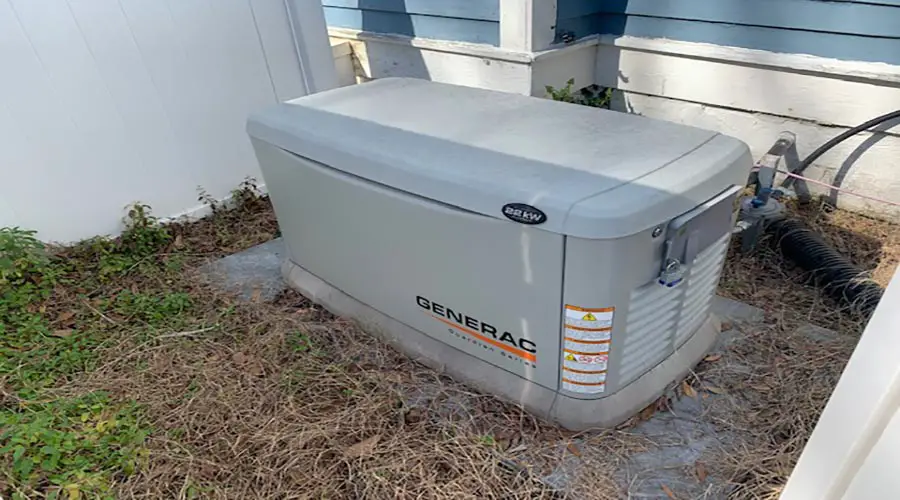
Troubleshooting generators can be a tricky task to perform, primarily if the generator in question has not been maintained or in use. Below we will present ten generator troubleshooting tips, different types of generators, maintenance tips, do’s and don’ts, and best practices.
- Visually check your fuel source, level, and condition
- Is the key turned?
- Does your generator have a manual choke, is it engaged?
- Inspect the oil condition and level
- Examine the oil filter and change it if needed
- Search the battery for corrosion or potential leakage
- Clean or replace the air filter
- Check the condition of the spark plugs
- Inspect and clean the carburetor
- Is your generator overloaded?
Troubleshooting When Your Generator Won’t Start
There can be many reasons why your generator won’t start. Below we will guide you through checking for potential issues and give you tips on how to deal with them.
1. Visually Check Your Fuel Source, Level, and Condition
It is always best to examine the fuel source condition before starting any generator, primarily if you have not operated it recently. Diesel and gasoline are both fuel sources whose quality degrades over time. When left in generators or engines for extended periods, it can damage the machines.
This is why you should never leave diesel or gasoline inside your generators. After using the generator, drain the gas or diesel from the fuel tank. Propane and natural gas, on the other hand, can last indefinitely. However, the containers, pipes, and fixtures that hold these fuels are more fragile and vulnerable to combustion, and you should inspect them regularly.
2. Is the Key Turned?
Many generators rely on a key and ignition system to turn on and start. If the key is not in the correct position, then the generator will not start. Key and ignition systems are standard on diesel and gasoline generators. Most key and ignition operated generators have a “Ready” light indicator which switches on when the key is turned to the correct position and closes the ignition circuit.
You can then start the generator by pressing the “Start” button, usually located on the same panel as the ignition key. Other key-operated generators use starter systems similar to those of automobiles to activate.
3. Does Your Generator Have a Manual Choke, and is It Engaged?
Most modern generators have automatic chokes. However, some older models still come with manual chokes. If you are wondering, a choke is a device that regulates the amount of oxygen the carburetor mixes with your fuel supply before combustion. To start a generator that operates with a choke.
First, start the generator with the choke disabled, normally with the choke knob pushed in. If the generator does not start, engage the choke at increments, followed by a starting attempt until the generator gets going. This process is automatic on newer generators that have electronic fuel injection.
4. Inspect and Clean the Carburetor
Diesel and gasoline generators of a specific model and type contain a carburetor, which is a mechanism that controls the dispersion rate of fuel from the fuel source to the engine. With use, the gasoline and diesel begin to gum up the carburetor, and it needs to be removed and cleaned with carburetor fluid.
In extreme cases, you need to replace the carburetor due to the damage caused by gelatinous diesel and petrol residue. To clean your carburetor will require you to remove it entirely and disassemble it completely, cleaning every part with carburetor fluid and reassembling it. This can be tricky, so we recommend contacting a professional.
Troubleshooting When Your Generator Starts and Then Stops

It is common for a generator to start up and suddenly die. Various issues can cause this, and we will discuss the most common ones and some tips to deal with them.
5. Inspect the Oil Condition and Level
Like with regular engines, you should regularly check your generator’s oil level and condition to ensure smooth operation. This is done by either locating and removing the oil dipstick and looking at the oil level indicated on it or the indicator mark inside the oil tank.
If there is not enough oil, you have to add oil that your generator’s manufacturer recommends. Or, for older models, you can use 10-30W high-quality oil. Degraded oil can also cause your generator to stall or stop working. Replacing the oil will solve this; however, you should preferably do this in tandem with the next step.
6. Examine the Oil Filter and Change It If Needed
If you have determined that you need to replace your generator’s oil, it is usually best to change your oil filter as well. To do this, first, disconnect the spark wire connected to the spark plug to avoid accidental ignition. Prepare an oil-catching container, locate the oil drain plug, maneuver the oil pan underneath, and gently remove the drain plug.
Ensure that all the oil drains into the container. While the oil is draining, you can replace the oil filter by loosening it with a wrench or, depending on the model, simply screwing on a new one. When the oil has drained, you can refill it with fresh oil, but make sure not to use too much.
7. Search the Battery for Corrosion or Potential Leakage
Some portable generators and many standby generators come with batteries. The purpose of the batteries differs for different types of generators. In the case of standby gas or gasoline-operated generators, the battery turns on the generator and automatically switches to the generator’s power source in a power outage.
Inspecting the batteries regularly for corrosion or leakage can prevent damage to your generator and power grid. When examing the batteries, ensure that the contacts are clear, the connectors are on the correct poles, and the battery is not leaking or damaged.
8. Clean or Replace the Air Filter
Most generators have an air filter of some sort. These filters ensure that clean and filtered air makes it into the engine. Without this filter, the machine would get damaged or not start at all. A damaged or dirty filter can also cause the generator to stall.
Because of the many different air filters and generators, it is always best to consult your generator’s manual to ensure that you have the correct air filter replacements. You can clean some air filter models, but it’s best to replace them to provide the best experience.
9. Check the Condition of the Spark Plugs
Generators that utilize spark plugs run the risk of malfunctioning due to plug failures or degraded contacts. As a general rule, it is well-advised to change the spark plugs on your generator every six to ten months. To determine whether the spark plugs malfunction, inspect them by removing the spark wire and cap from the spark plug.
Look around the plug for cracks in the porcelain or build-up around the edges and on the tips. If the porcelain has a crack, the spark plug is defective. To determine if a spark plug is still usable, you need a spark plug tester. Otherwise, replace them and clean the contacts.
10. Is Your Generator Overloaded?
This might seem pretty obvious to examine, but a significant number of people do not understand the science behind generators and how much power a generator can safely generate. A generator with a power rating of 2000 watts will allow you to power a fridge, laptop, ten lights, phone charger, and security system.
These are only essentials. Realistically you would need at least 8000-10000 watts to run a house. When powering up your generator, ensure that only the essential appliances required are connected.
Different Types of Generators

There are two main groups of generators, portable and standby generators. The difference being cost and power. Below we briefly explain the differences, benefits, and purposes of the different generators.
Portable Generators
Portable generators are by far the most inexpensive and popular type of generators. They are usually powered by gasoline, diesel, propane, inversion, or even hydrogen in some cases. The power, emissions, noise, heat, and cost may differ widely depending on the type.
Despite all the differences, all generators function according to the same basic principles to generate electricity. Portable generators must be activated manually and require a transfer switch when connected directly to a house’s electrical system. Portable generators can generate up to 26000 Watts of electricity but, as mentioned before, at a cost.
Standby Generators
Generators of this type are generally stationary and built into large facilities. They use gasoline, diesel or propane, natural gas, or solar power to generate considerable quantities of power. Standby Generators are also larger and more expensive than portable generators because of the installation fees and the change to the infrastructure when installed.
These generators are usually installed with an automatic transfer switch that supplies power when it detects that the main power supply has failed. Standby Generators require a lot of maintenance, and you should service them regularly to ensure the best functionality.

